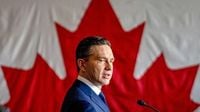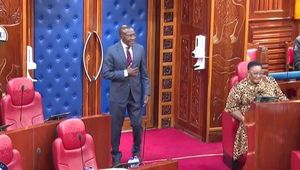On Monday, August 18, 2025, the rural Alberta riding of Battle River-Crowfoot found itself thrust into the national spotlight as voters headed to the polls in a by-election that is anything but ordinary. With a record-shattering 214 candidates on the ballot—including Federal Conservative Leader Pierre Poilievre—the contest is remarkable both for its sheer scale and its political significance. The outcome could have ripple effects far beyond the windswept plains of eastern Alberta, stretching from Edmonton to Calgary, as it marks a pivotal moment in Canada’s shifting political landscape.
Battle River-Crowfoot, a sprawling constituency known for its agricultural heartland and deep conservative roots, has been a Tory stronghold for a century. According to Global News, in every election from 2004 to 2025, the Conservative candidate’s vote share has never dipped below 80 percent—except in 2021, when a surge from the right-wing People’s Party of Canada saw the Conservative incumbent Damien Kurek slip to 71 percent. But this year’s by-election, called after Kurek stepped down in June to allow Poilievre to run, is shaping up to be a test not just of party loyalty, but of the Conservative leader’s own political future.
Julie Simmons, a political science professor at the University of Guelph, captured the stakes succinctly: “In every election from 2004 to 2025, the vote share garnered by the Conservatives’ winning candidate has been at least 80 per cent.” She noted that the only exception was 2021, when the People’s Party siphoned off enough support to make a dent. “This is just certainly an exceptionally strong riding for the Conservative Party,” Simmons said, underscoring the expectation that Poilievre would win handily. The real question, she suggested, is not whether he will win, but by how much.
That sentiment was echoed by Lori Williams, a political science professor at Mount Royal University in Calgary. Williams argued that Poilievre needs not only to win, but to do so decisively, to reassure party faithful and position himself as a credible Opposition leader ahead of his January leadership review. “He absolutely needs to sail over this hurdle,” Williams told Global News. “But if he clears this one, he’s then got to clear the, ‘How am I going to be an effective Opposition leader in this climate? How can I be pro-Canadian and critical of the government?’”
The by-election comes on the heels of a bruising federal election earlier this year in which the Conservative Party lost to the Liberals for the fourth consecutive time, leaving Poilievre without a seat. He lost his long-held Ottawa-area riding to Liberal Bruce Fanjoy, a defeat that forced him to seek a new political home. The decision by Kurek to step aside and make way for Poilievre in Battle River-Crowfoot was seen by many as a strategic move, designed to ensure the Conservative leader’s continued presence in Parliament and his ability to challenge Prime Minister Mark Carney, who has emerged as a formidable political opponent.
Yet, the path to victory is not entirely without obstacles. For the first time in Canadian history, the ballot is blank—a logistical necessity given the unprecedented number of candidates. Instead of marking an X beside their preferred candidate, voters are required to handwrite the name in a blank space. As The Economist wryly observed, “Voters of a conservative bent in the riding, or constituency, of Battle River—Crowfoot in rural Alberta should give a bit of thought to the spelling of Pierre Poilievre’s name.” In a nod to the practical challenges of democracy, Elections Canada has assured voters that misspelled names will still be counted, provided the voter’s intent is clear.
The ballot’s unusual format stems in part from the presence of the Longest Ballot Committee, a protest group whose members are seeking to draw attention to perceived flaws in Canada’s electoral system. Many of the 214 candidates are affiliated with this group, and their participation serves as a form of protest against the status quo. Simmons suggested that the sheer number of candidates could put a dent in Poilievre’s vote share, as some voters may use the opportunity to register a protest vote against the Conservative Party. “For some people, this might be a protest vote against the Conservative Party,” she said.
Poilievre also faces vocal opposition from Independent candidate Bonnie Critchley, a military veteran who has described him as a parachute candidate more interested in advancing his political career than representing local interests. Poilievre, who was born and raised in Calgary but has spent the last two decades in Ottawa, has had to contend with criticisms that he lacks a genuine connection to the riding. Other notable candidates include Darcy Spady, representing the Liberals and hailing from the energy sector; Katherine Swampy, the New Democratic Party candidate and a former band councillor for the Samson Cree Nation; and Michael Harris of the Libertarian Party, who is running on a platform that includes holding a referendum on Alberta’s separation from the rest of Canada.
Despite these challenges, the numbers suggest that Poilievre remains the odds-on favorite. According to Elections Canada, more than 14,000 people out of almost 86,000 registered voters cast ballots in advance polls—a testament to the high level of interest in the race. The turnout, while not extraordinary, reflects the riding’s reputation for political engagement and the sense that this by-election is about more than just filling a vacant seat.
Logistics have played a starring role in this election, with thick, coil-bound, 32-page laminated booklets listing all 214 candidates available at voting stations. The blank ballot, while novel, has also complicated the process: Elections Canada has warned that counting will take longer than usual on election night. The agency’s spokesperson explained that the unique voting method, combined with the sheer volume of candidates, means results may not be finalized until well after polls close. Poilievre’s campaign has indicated that the Conservative leader plans to be in Camrose, the riding’s largest municipality, on election night to await the outcome.
For Poilievre, the stakes are clear. A decisive victory would not only restore his seat in Parliament but also reaffirm his leadership at a time when the Conservative Party is searching for direction after yet another federal defeat. For the voters of Battle River-Crowfoot, the by-election is a rare opportunity to make history—by participating in Canada’s largest-ever ballot and, perhaps, by influencing the future course of national politics. And for the country as a whole, the contest stands as a vivid reminder of both the enduring strength of local democracy and the unpredictable nature of political renewal.
As the ballots are counted—letter by painstaking letter—the nation watches to see whether Battle River-Crowfoot will once again deliver a resounding Conservative victory, or if the winds of change are beginning to stir on the prairie.




